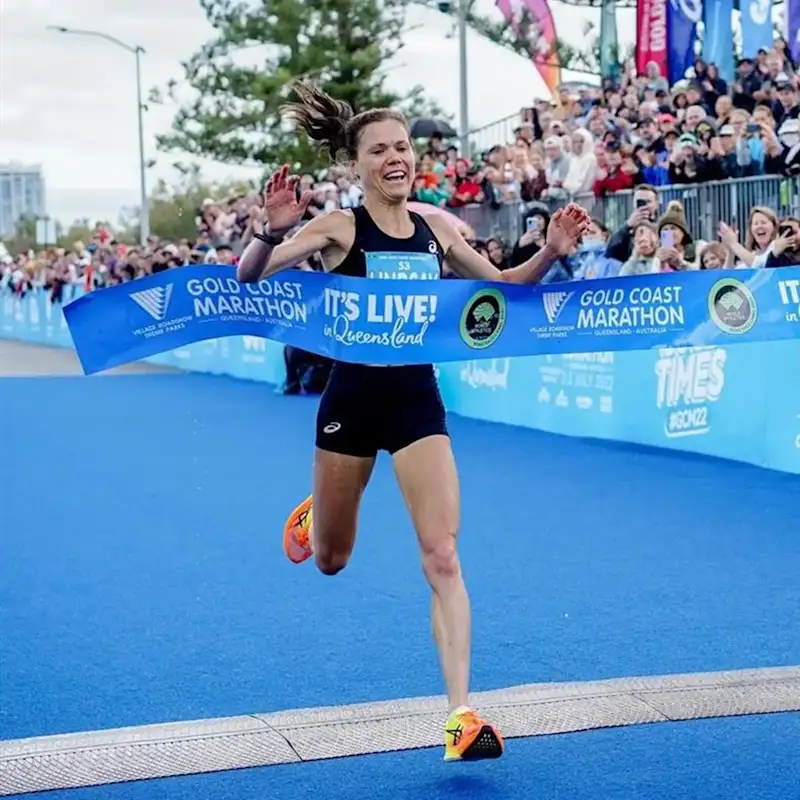
Lindsay Flanagan
US Olympic Marathon Trials
Lindsay's headline numbers
Lindsay's strategy
Fueling
Carbohydrate is the main fuel you burn when racing. Failing to fuel properly is a leading cause of underperformance in longer races.
Lindsay consumed a lower carbohydrate intake in comparison to her last marathon race, as a result of dropping her first gel from her bottle around the 6 mile mark and having less access to bottles on course (the Olympic trials have only six pro aid stations compared to the usual eight). Lindsay continued to implement her strategy of alternating between half-full 500ml bottles of PF Carb & Electrolyte Drink Mix or plain water along with a PF 30 Gel to get carbs on board, but could have benefitted from carrying spare gels in her sports bra to still reach her fuel targets. After trialling it in training, Lindsay also included a final half gel 15 minutes before the start to spike her blood glucose levels and save digging into her fuel stores until later in the race. She perceived this to greatly benefit her energy levels early in the race and may look to test upping this dose to 30g of carb with caffeine in future to maximise the possible benefits. Unfortunately over the last eight miles, she experienced some gut discomfort but after extensive gut training over the last year she doesn’t put this down to fueling, saying her stomach felt off on the morning of the race.
Hydration
Taking on board an appropriate amount of fluid and sodium is essential to maintaining blood volume and supporting the cardiovascular effort needed to perform on race day.
Whilst the absolute amount of sodium and fluid consumed per hour is important, it’s critical to consider these in relation to each other. This is known as 'relative sodium concentration' and it’s expressed in milligrams per litre (mg/L). How much sodium you’re taking in per litre of fluid is more important than the absolute amount taken in per hour.
Sweat sodium concentration (mg/L) is largely genetically determined and remains relatively stable. Knowing how salty your sweat is enables you to replace a good proportion of your sweat losses, which can range from 200-2,000mg/L.
Whilst Lindsay’s losses are on the low side, getting her hydration strategy right is still important if she wants to perform at her best.
Learn moreIn the milder conditions of Florida, compared to her previous race in Budapest, Lindsay planned to drink less fluid to reflect her lower sweat rate. After collecting plenty of sweat rate data last year, Lindsay knew this lower volume would be sufficient to avoid accumulating a significant level of dehydration to hinder performance. Four of Lindsay’s bottles contained sodium in the form of PF Carb & Electrolyte Drink Mix, which she effectively diluted with two further bottles of water. This meant she took on an overall relative sodium concentration of ~725mg/L, similar to that of her sweat sodium concentration (696mg/L).
Caffeine
Beyond the Three Levers of Performance (carb, sodium and fluid), caffeine is one of only a few substances that is proven to improve performance for most endurance athletes as it can help stave off mental and physical fatigue.
Caffeine has a half life of around 4-5 hours (meaning half of what you take will still be circulating in your bloodstream after this time), therefore the dose from her morning espressos would still have been present during the race. In future, Lindsay may want to trial swapping two normal gels for one or two caffeine gels to reach the recommended levels, and maximise its ergogenic effects.
How Lindsay hit her numbers
Here's everything that Lindsay ate and drank on the day...
Lindsay's weapons of choice
Final thoughts
Lindsay's full stats
Data Confidence?
There is good confidence in the accuracy of the data reported. An athlete feels that the numbers closely reflect what they consumed despite a couple of estimations which may carry some degree of error. The majority of what was consumed is recorded to a high level of specificity (most volumes are known through the use of bottles brands quantities flavours). The numbers are very plausible and align with previous data recordings (if an athlete has collected data previously).